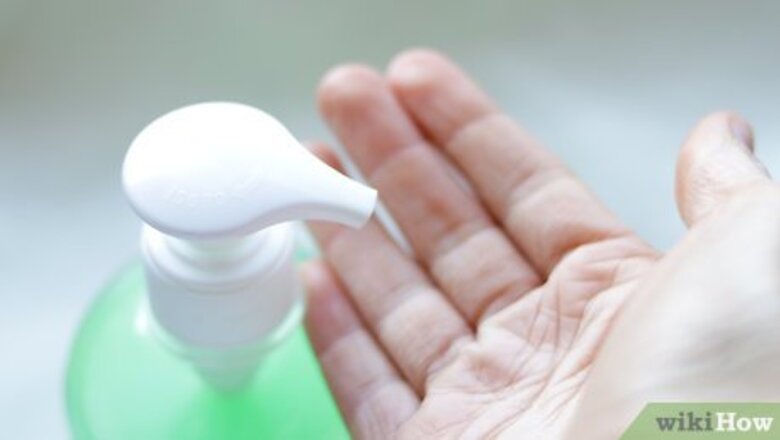
views
Placing the Contacts onto Your Eye

Wash your hands with fragrance-free soap and warm water. Wet your hands, then apply soap and scrub for at least 30 seconds. Rinse your hands thoroughly to get rid of any soap residue. Pat your hands dry on a clean microfiber towel to avoid lint. Always use a clean, dry towel to dry your hands. Microfiber towels are your best option because they’re less likely to leave lint or fuzz on your hands, which might get on your contacts. If you don’t have a microfiber towel, you might consider letting your hands air-dry if your eyes are sensitive.
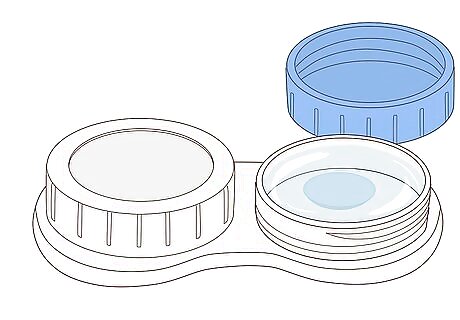
Remove the lid on one side of your contact lens case and set it aside. Only open 1 side of your contact case at a time to help you avoid mixing up your contacts or accidentally damaging one. Get into the habit of always doing the same side first. For instance, you might do your right eye and then your left.
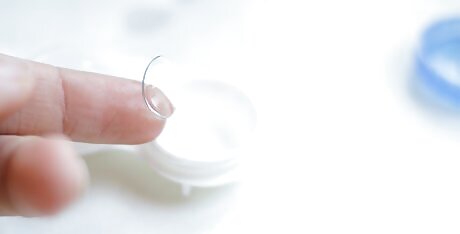
Use your fingertip to slide the contact lens from the case. Tilt the case toward you, then lightly press the pad of your finger over the contact lens. Once the lens is on your finger tip, slowly pull your finger out of the container and transfer the lens to the palm of your hand. Don’t use your nails to get the contact, as this may damage it. Be very careful with your contacts because it’s easy to damage them.Tip: If your contact gets stuck to the side of the case, gently shake the case to dislodge it. You might also spray the contact with more solution to moisten it.
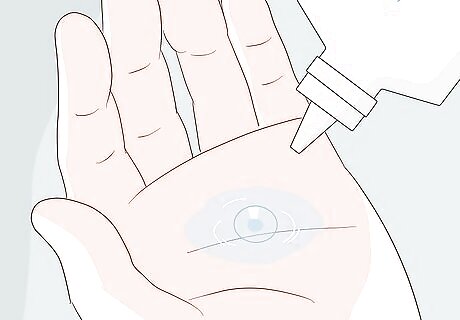
Rinse the contact lens with your contact solution. Position the contact in the center of your palm, then spray a stream of contact solution over it. Do a visual inspection to make sure your contact is free of debris. You don’t need to rub the contact unless you see some debris on it. If you see any debris on the contact, apply more contact solution to it and lightly rub it with your fingertip to remove the debris. Never, ever use tap water on your contacts. Only use contact solution to rinse your contacts.
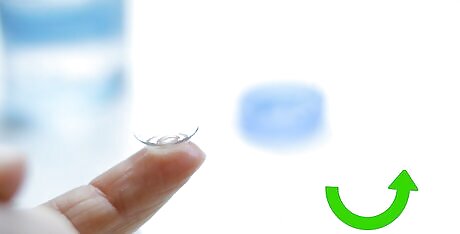
Place the contact concave side up on your index finger. Put the contact on the skin of your finger, not your nail. Make sure that the contact is sitting hollow-side up on your fingertip with none of the side walls sticking to your finger. It should look like a tiny bowl. If the edges are flaring out, then it is inside out. Put it back on your palm and use your fingertip to gently flip it right side out.
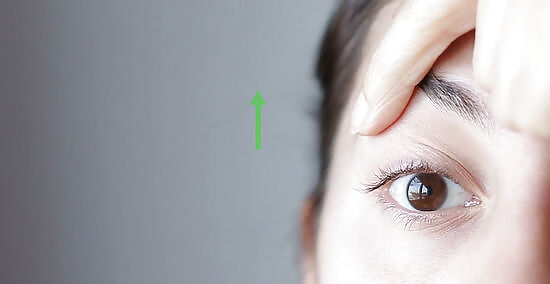
Hold your eye open with your middle finger and opposite hand, if necessary. Look in the mirror. Then, gently pull your eyelid down using the middle finger of the hand that’s holding your contact. If your eyes are very sensitive to touch, you may also need to hold your upper eyelid open. Use your opposite hand to gently lift and hold the upper eyelid to keep it from blinking. This will expose more of your eye, allowing you to more easily place the contact onto it. You only need to hold your top eyelid open if it keeps blinking or your eye is very small. This is normal when you first start wearing contacts, as you’re not used to putting things in your eye. Over time, you may not need to hold your upper eyelid open anymore.
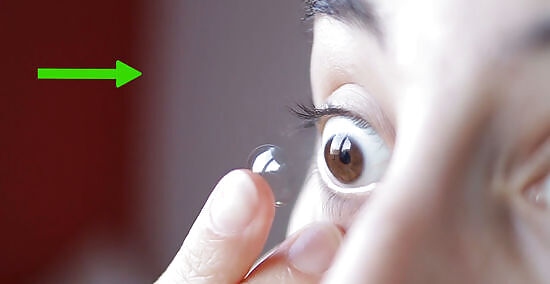
Move the contact towards your eye calmly and steadily. Try not to blink or move jerkily. It may help to look upwards so that you don’t accidentally blink on reflex. Additionally, do your best not to focus on the eye you’re putting the contact into, which will make it easier to not blink.
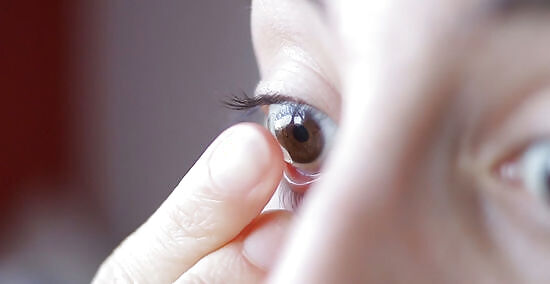
Place the contact on your iris gently. Put the contact up close to your eyeball and lightly press it in place. The contact should easily go onto your eye, as it will be attracted to the moisture. Then, remove your finger from your eye. The contact needs to be over your iris, which is the colored part of your eye. Try to put it directly over this area, if you can.Variation: If you can't stop blinking, look upward and place the contact on the white part of your eye. Hold your eye open and roll your eye down toward the contact. Then, gently lift your upper eyelid and bring it down over the contact. Finally, lightly press over your eyelid to remove any air bubbles so the contact stays in place.
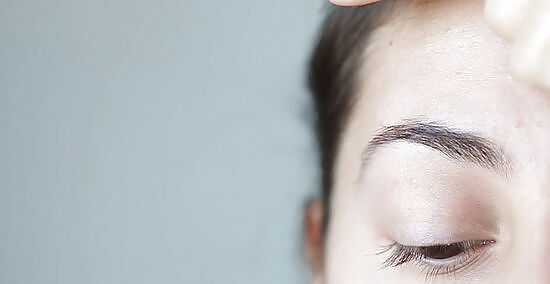
Let go of your eyelids and blink slowly until the contact is comfortable. Blink slowly several times, being careful to not dislodge your contact. Look in the mirror to check that the contact is in place and that you can see. Notice if you feel any pain or irritation in your eye. It should feel comfortable. If the contact feels itchy or painful, remove it and clean it with solution. Then, try inserting it again.
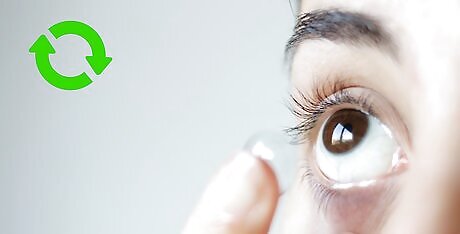
Repeat the process with the other contact. Once both contact lenses are in your eyes, look around to make sure you can see well. When you’re finished, pour the contact solution from the case into the sink, rinse the case, and close the contact case. Never reuse old contact solution, as it increases your risk of getting an eye infection. Always use fresh contact solution.
Removing Your Contact Lenses

Wash and dry your hands. Wet your hands with warm water, then scrub them for 30 seconds with soap. Rinse your hands thoroughly, then dry them on a clean microfiber towel. Try not to get any lint on your hands from the towel. Make sure your towel is clean and dry.

Lubricate your eyes with contact-safe eye drops if you have dry eyes. This step is optional, but it may help you if your contacts tend to dry out on your eyes. The drops will wet your contact so that it comes off more easily. Squeeze 2-3 of drops of lubricating and rewetting solution into your eyes to wet them. Check the label to make sure your rewetting drops are approved for use with contacts. If they aren’t, don’t use those drops, as they’ll damage your contacts. If you don't have rewetting drops, you can use saline solution to wet your eyes. However, you shouldn't use contact lens cleaning solution, which can dry or irritate your eyes.
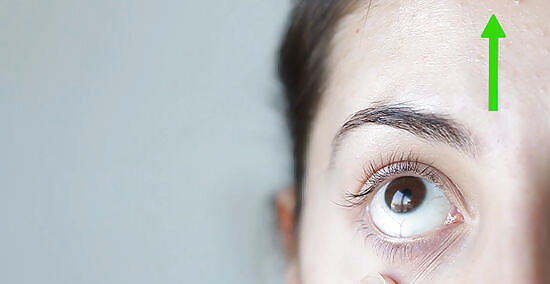
Pull your eyelid down with your finger. Use your middle finger to expose the lower part of the whites of your eye. Hold the eyelid in place while you remove your contact. If your contact feels out of place before you remove it, blink a couple of times to help it recenter over your iris.
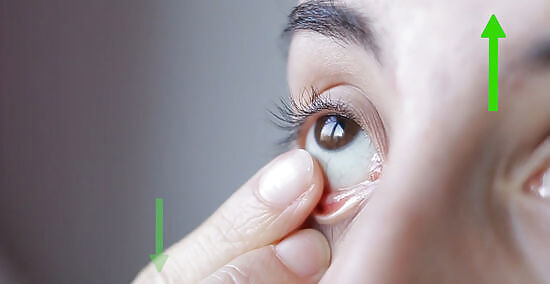
Touch the contact with your index finger and slide it down. Use the pad of your finger to lightly touch the edge of the contact, which should stick to your finger. Then, slowly pull the contact down toward the bottom of your eye. You should feel the contact start to fold when it reaches the edge of your lower eyelid.
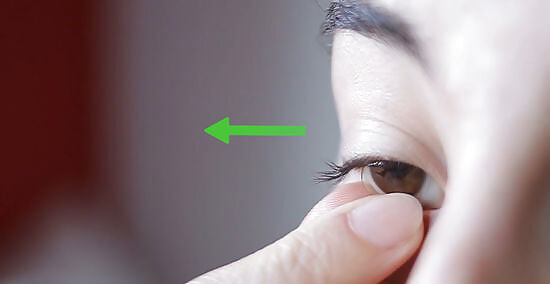
Squeeze your index finger and thumb around the contact to remove it. Gently press your fingers around the contact and pull it from your eye. Be careful as you handle the contact so that you don’t accidentally rip or tear it. Always use the pads of your fingers when you’re touching your contacts. Using your nails may damage your lenses.

Put the contact in your palm and clean it. Place the contact face up in your palm, then spray it with contact lens cleaning solution. Lightly rub each side of the contact lens to get it clean. Finally, rinse it again to remove any remaining debris. If the contact is old or damaged, throw it away.

Place the contact in its case and add fresh contact solution. Gently drop the contact into the lens case, then fill the case with fresh contact solution. Replace the cap over the contact to keep it safe. Make sure you store your contact in the correct side of the lense case. Don’t use old contact solution. Be sure to use fresh solution each time you store your contact.

Repeat the process to take out the other contact. Gently pull down your eyelid and remove your other contact. Clean it with your contact lens solution, then place it in the correct side of your contact lens case. Fill the case with water, then secure the lid in place. Tip: It’s important that you take good care of your contact lenses by cleaning them every day and storing them in fresh solution. Your eye health is very important, so don’t risk it.
Using Best Practices

Inspect your contact for rips, tears, or debris before putting it on. You don’t want to put the contact in your eye if it may cause irritation. Hold your contact near your eye and check it over for any damage or dirtiness. If your contact looks damaged, throw that contact away and use a new one. If you see any dust or debris on the contact, rinse it clean with contact solution.

Replace your contacts according to your doctor’s instructions. Most contacts are disposable, meaning you change them frequently. Depending on the type and brand of contact you’re wearing, your doctor will likely tell you to change them daily, weekly, biweekly, or monthly. Always stick to this schedule and change your contacts as directed. This will help you keep your eyes healthy. Soft contacts are typically changed either every day, weekly, biweekly, or monthly. Extended wear contacts can be worn overnight, and they're typically changed weekly, biweekly, or monthly, depending on the brand and your individual needs. Rigid gas permeable lenses last much longer and may be worn for up to a year. However, your doctor will give you additional cleaning instructions for maintaining these lenses, which aren't prescribed often. Don’t try to save money by wearing your contacts for too long. Your contacts were formulated to last for a certain period of time. After that point, they start to deteriorate, making them less comfortable and more likely to collect germs, bacteria, or debris that can harm your eyes.
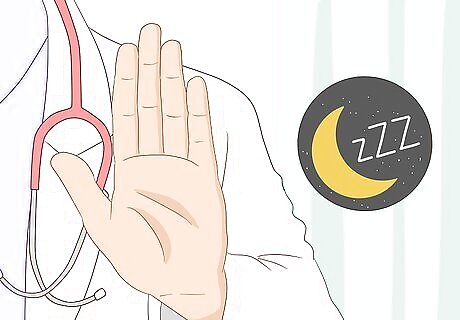
Sleep in your contacts only if your doctor approves it. Taking off your contacts every night may seem like an inconvenience, but it’s very important. Sleeping in contacts that aren’t labeled for extended wear can dry out your eyes, expose your eyes to more bacteria, and lead to serious complications, like ulcers. Always remove your contacts at night unless your doctor tells you it’s safe to sleep in them. If you have dry eyes, you may not be able to sleep in contacts even if they’re approved for sleeping. Talk to your doctor if you think you have dry eyes.
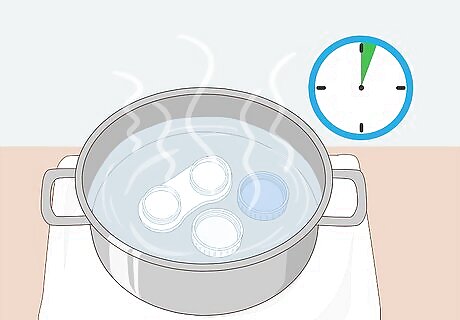
Clean or replace your contact lens case every 3 months. It’s normal for a contact lens case to get dirty over time. To clean your case, bring a pot of water to boiling. Next, put the contact lens case into the boiling water and wait at least 3 minutes. Remove the water from the heat, then use tongs or a slotted spoon to remove the contact lens case from the water. Let the case cool before handling it. Finally, rinse it with saline solution before using it again. As an alternative, replace your case with a new one, which may be the safest option.Warning: If your case looks damaged or cracked, replace it immediately, regardless of how long you’ve had it. Using a damaged or cracked case increases your risk of developing an infection.
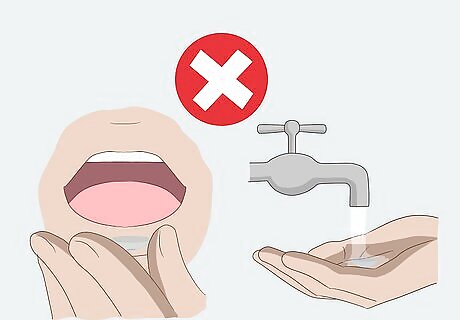
Avoid using saliva or tap water to clean your lenses. Don’t ever put your contacts in your mouth to clean them, as this will make them very dirty. Your saliva isn’t sterile, and it will introduce germs and bacteria to your lenses. Similarly, tap water is also not sterile, and any bacteria or chemicals in the water will stick to your contacts. Additionally, both saliva and water will dry out your lenses. Always clean your lenses with a contact solution. It’s helpful to carry a bottle of contact solution with you when you’re out. You can even find a trial sized version to make it easier to fit in your bag.
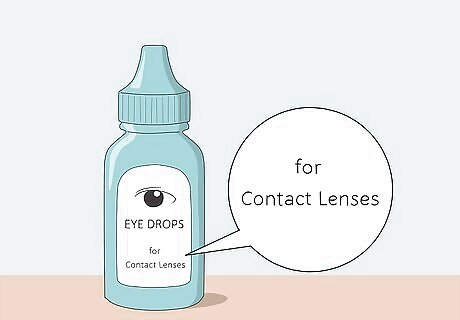
Make sure eye drops are labeled for use with contacts. Most eye drops will dry out your contacts, even if they're labeled for treating dry eyes. If you want to moisten your eyes while you're wearing contacts, read the label to find out if the drops are safe for contacts. Eye drops that are safe to use with your contacts are typically kept near the contact lens solution at your local drug store. Otherwise, you can buy them online.
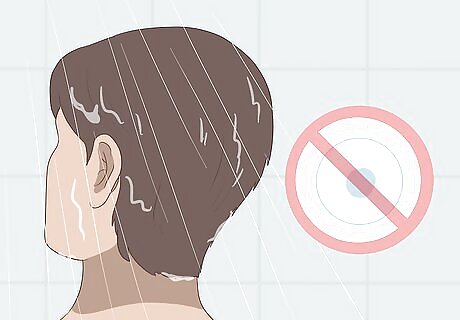
Remove your contacts before you take a bath or shower. Your contacts can easily get damaged in the shower because tap water and suds from your personal care products can get onto your lenses. This can dry out your contacts and leave behind residue and potentially harmful bacteria. Always remove your contacts before your bath or shower so that you contacts don't get ruined. If you wear your contacts in the bath or shower, you may develop an eye infection.
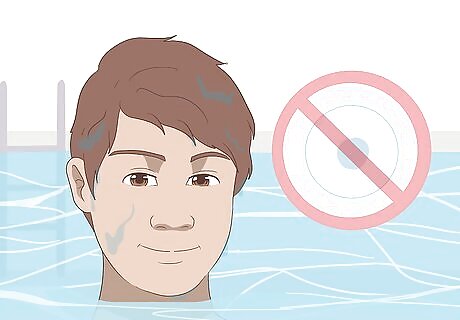
Avoid swimming or using a hot tub while wearing your contacts. Pools, waterways, and hot tubs contain bacteria, germs, and sometimes chemicals. Splashing water or water on your skin can get into your eyes and on your contacts, which may damage or contaminate your contacts. This can cause eye irritation or an eye infection. Instead, take off your contacts before you get into the water and wear your glasses. It's not safe to wear contacts you wore while swimming, even after you clean them.

Keep a pair of back-up glasses in your current prescription. Although you might wear your contacts most of the time, you need to have a pair of backup glasses for times you aren’t wearing them. Wear your glasses at night to give your eyes a break from your contacts. Additionally, wear your glasses if you’re experiencing any eye irritation or think you may have an infection. Visit your eye doctor if you think you may have an infection. If you’re worried about the cost of your backup glasses, look for a budget option. For instance, you can buy glasses online for as low as $6.95. Just ask your doctor to give you a copy of your prescription and to write your pupillary distance (PD) on it, which is a measurement you’ll need to buy your glasses.


















Comments
0 comment